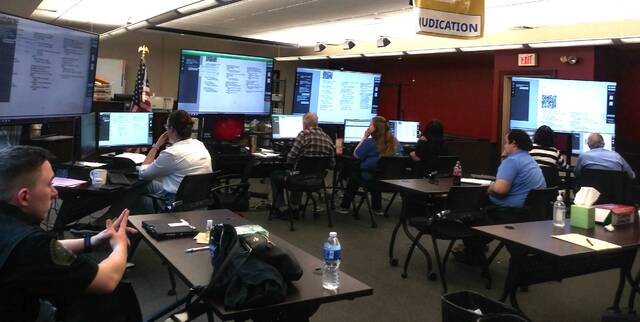A partially shaded ballot bubble has earned Michael Cabell another vote, despite strong objections from his opponent, Jamie Walsh, in the Republican race for state representative in the 117th District.
Cabell obtained the extra mail ballot vote on Tuesday during the Luzerne County Election Board’s ongoing adjudication process.
Although it is not yet shown in the county’s unofficial online April 23 primary election results database, the decision reduces the vote difference between Walsh and incumbent Cabell from four to three, with Walsh in the lead.
This ballot was one of those flagged by the voting system for various reasons, including stray marks and bubbles that are not fully shaded.
Election Board Chairwoman Denise Williams mentioned that the board frequently encounters bubbles that are not fully shaded during the public adjudication and must review them and make a decision.
In this case, Williams stated that approximately one-third of the bubble next to Cabell’s name was shaded, and a majority of the board agreed that it was sufficient to indicate voter intent in selecting Cabell.
Williams supported accepting the selection along with fellow members Albert Schlosser and Daniel Schramm.
Board Vice Chairwoman Alyssa Fusaro voted against counting the vote. Rick Morelli, the fifth board member, was absent.
Fusaro explained that she did not believe this vote should be counted because most of the shading was in the empty space between the bubbles for Cabell and Walsh.
She said she makes all decisions based on the facts and clear voter intent, and she voted no in this case because the voter intent was unclear.
Walsh said the voter in this instance “hit dead center on the target” of shading in bubbles for all other races except the 117th District one.
Walsh’s bubble was above Cabell’s on the ballot, and he believes the voter started shading in the upper portion of Cabell’s circle and “then squiggled toward mine.”
No shading reached Walsh’s bubble, but Walsh said the ballot review system indicated only 33% of Cabell’s bubble was shaded.
“If the voter started at the bottom of Mike’s oval and went down I could see, but why did the voter start at the top of Mike’s oval and go up?” Walsh said. “How can anybody say with 100% conviction that this voter’s intent was to vote for Mike when only 33% of the oval was filled?”
After the board voted to approve the selection on Tuesday, Walsh asked if the board would reconsider and vote again on Wednesday, when all five board members were expected to be present. Walsh said the board voted on that request, but it failed due to a 2-2 tie vote.
Walsh said several other ballots with bubble-shading issues surfaced after the one in his race, and the board “quarantined” them until Wednesday’s board vote.
“I asked for the same courtesy that all of these other ballots are getting,” Walsh said.
It’s unclear when results from this portion of adjudication will be uploaded to the county database because the board’s current review also includes write-in tallies that are typically posted in one final batch at the conclusion of the process.
Fusaro mentioned that there are over 7,700 ballots left for the board to make decisions about. The board will meet at 9 a.m. on Wednesday with the aim of staying until all these ballots are decided on, Fusaro said.
Where things stand
For those trying to keep track, a certain number of possible votes are still in play in the 117th District:
• A county court is still deciding on six mail ballots Walsh tried to throw out.
These votes were already included in the count and would have to be removed if the court rules in favor of Walsh.
• Cabell appealed to the court on Monday to count one provisional ballot, reject another, and give credit for at least five write-in votes.
If the court rules in favor of Cabell on any of these, the ballot selections would be added to the current unofficial count.
• Twelve election board-approved provisional ballots cannot be counted yet. This is because even though they were not disputed by candidates, one in this group is under appeal by Cabell.
Lawyers have said the counting of this whole group must wait until all appeals are decided. As they are still sealed, it's not possible to know which candidates these voters chose. Before any of these votes can be counted, the board must also check to confirm that the ballots are in inner secrecy envelopes without any marks identifying the voter who cast them — problems that would lead to the board rejecting them.



